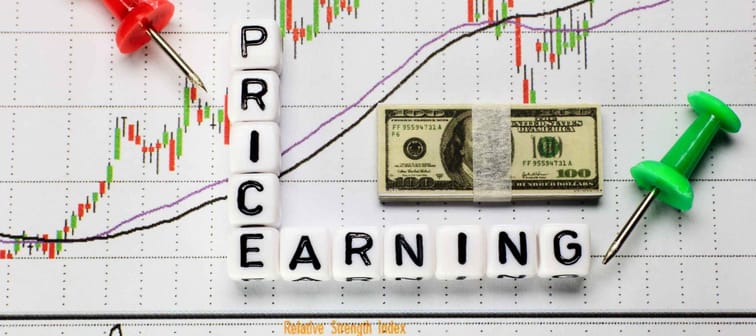Defining the P/E ratio
As its name indicates, the P/E ratio is quite simply a company's stock price, P, divided by its (annual) earnings, E. So, for example, if XYZ Co.'s stock is priced at $90 and its earnings per share is $6, its P/E ratio is 15.
Of course, this example produced a nice round number (we like simple examples). In real life, the P/E ratio is likely to have something other than zero to the right of the decimal point. Don't let that throw you off. And you can ignore anything beyond the first decimal place. It really doesn't matter if the exact P/E ratio is 15.32 or 15.34; 15.3 is good enough.
The P/E ratio quite literally tells us, “Investors are willing to pay (insert P/E ratio as a $ value here) today for every $1 of this company's earnings.” So, in the case of XYZ Co., investors are willing to pay $15 for every $1 of the company's earnings. We can also say the stock is “trading at 15 times earnings.”
Meet Your Retirement Goals Effortlessly
The road to retirement may seem long, but with WiserAdvisor, you can find a trusted partner to guide you every step of the way
WiserAdvisor matches you with vetted financial advisors that offer personalized advice to help you to make the right choices, invest wisely, and secure the retirement you've always dreamed of. Start planning early, and get your retirement mapped out today.
Get StartedTurning it upside-down
Now, you may be thinking, “Why would I pay anything more than $1 to get $1 of a company's earnings?” Perhaps the best way to answer that is to introduce one of the related measures mentioned earlier, the earnings-to-price, or E/P, ratio. We obtain this by turning the P/E ratio upside-down. The E/P is less famous than the P/E but is also quite useful. In our example, we invert 15/1 and get 1/15, or 0.0667. We'll express as a percent: 6.67%.
You can think of the E/P as the return you would earn by paying today's stock price to get your hands on the earnings per share. In our example, you would be paying $90 to get $6 in earnings per year. And remember, that's just the return you would get from the earnings. It doesn't include any return from an increase in XYZ Co.'s stock price.
If investors were willing to pay only $1 today for $1 of earnings, that would equate to a return of 100%. Nice if you can get it but completely unrealistic. That would be such a great deal, investors would buy more and more of the stock. That would push up the stock's price, which would push down the E/P ratio to a more reasonable level.
Interpreting the P/E
Note that as a stock's P/E ratio goes up, its E/P goes down, and vice versa — that's just math. What this means is that as the P/E ratio increases, the “return” or “yield” each dollar of earnings represents decreases. That's what the lower E/P reflects. This is why many people say that stocks with a high P/E ratio are overvalued.
But what is considered a high P/E? What is a low P/E? Let's look at the P/E ratio for the U.S. stock market over time, as represented by the S&P 500 index.

The blue line shows the monthly P/E ratio for the S&P 500 over the past 90 years. The green line is the average over that entire time, which is about 17.0.
The thing about an average, though, is that if you compute it over a different period of time, it often changes. If we exclude the wild period of the Financial Crisis of 2008–2009, the average PE is about 16.1. So take your pick. We can say that a stock with a P/E ratio significantly higher than 16 to 17 is “expensive” compared to the long-term average for the market, but that doesn't necessarily mean the stock is “overvalued.”
Stop overpaying for home insurance
Home insurance is an essential expense – one that can often be pricey. You can lower your monthly recurring expenses by finding a more economical alternative for home insurance.
SmartFinancial can help you do just that. SmartFinancial’s online marketplace of vetted home insurance providers allows you to quickly shop around for rates from the country’s top insurance companies, and ensure you’re paying the lowest price possible for your home insurance.
Explore better ratesThe details matter
If a stock has a high P/E ratio, we can interpret that to mean that investors are willing to pay a high price for each dollar of that company's earnings (assuming those earnings stay the same, which we'll discuss a bit later).
To help you decide whether a stock really is overvalued (and there is no official pass/fail test that says, “Yes, this stock is overvalued”), you need to know why investors have sent its P/E ratio upward. This takes us to the fine print of computing the P/E ratio. To really understand what the PE is telling you, it is important to dig into its components a bit more deeply, especially the earnings part, but also price.
Which EPS, actual or forecasted?
First, we need to know which earnings per share value was used to compute the P/E ratio. One choice is to use actual earnings — the sum of the four most recent quarterly earnings per share. This is sometimes shown as EPS (ttm), where “ttm” = “trailing twelve months.” An alternative would be forecasted earnings, usually an average of various stock analysts' forecasts of the next four quarters of earnings. Both approaches have merit.
A big advantage of using actual EPS is that those earnings are, well, actual. They are not a result of inherently uncertain forecasts of things that affect future earnings. Such things can include future sales, expenses, new product development, etc. Also, it is easy to obtain actual EPS, while earnings forecasts can be harder to find, especially for smaller companies that are not followed by many analysts.
The disadvantage of actual earnings is that they are yesterday's news. So many factors could make the coming year's EPS significantly different from the most recent actual EPS. Consider an energy company's actual versus forecasted earnings if crude oil sold for $40 per barrel last year but is headed for $70 this year. Or earnings of a firm whose brand was the trendsetter last year but seems to have lost its mojo.
Also note that earnings are affected by accounting rules that can distort the picture of a company's profitability. (Although by and large, accounting rules do a good job of holding companies, ahem, accountable to readers of their financial statements.) Sometimes a company's earnings are significantly affected by one-time events, positive or negative. In such a case, you are better off using forecasted earnings rather than the prior year's actual earnings.
You will also want to know whether a P/E ratio was computed using a “basic” or “fully diluted” EPS. “Fully diluted” results in a lower EPS (and thus a higher PE).
Are high PEs irrational?
Although it is quite common to use last year's earnings in the P/E ratio, the result is inherently a bit of a mishmash, because price is intrinsically forward-looking. Today's price reflects the market's consensus expectations for future earnings. This gets at the heart of why some stocks have stratospheric P/E ratios — sometimes well over 100.
For example, in early May 2018, Amazon's stock price was $1,591 per share. At the time, its prior year's earnings were $6.15 per share, and the EPS forecast for the coming year was double that, at $12.34 per share. That gave Amazon a P/E multiple of 258.7 based on actual earnings or 128.9 based on forecasted earnings. Both are obviously many times greater than the average of the S&P 500.
Are investors crazy? These PEs equate to EPs of 0.387% and 0.776%, respectively. Who would buy a stock with an expected return of less than 1%? And these PEs are equivalent to saying it would take either 128.9 or 258.7 years to recoup your money if you were to buy the stock at this price, assuming you are counting on Amazon generating the same earnings, year after year after year.
But the stock price is telling us something very different. The price is looking forward and is telling us that investors expect Amazon's earnings to continue to grow significantly over time. Remember, analysts are forecasting that Amazon's earnings will double this year versus last year. If earnings continue to double, in four years the EPS would be $98.40. Given the May 2018 price, that would result in a P/E multiple of 16.2. Yes, exactly average for the overall market. If you think Amazon's earnings might be on that kind of trajectory, maybe today's PE isn't so crazy after all.
This is why it is difficult to say whether a high PE means a stock is overvalued. It depends on one's outlook for future earnings. However, a high PE should make you stop and think about why the stock is priced so high relative to its earnings. The same thing applies to the overall stock market. If the market's PE is high relative to historical averages, maybe that's a warning sign. But maybe it means investors are optimistic about future earnings. That's one of the things that makes the P/E ratio so useful; it helps us to ask the right questions.
What if earnings are negative? In that case, the P/E ratio is meaningless and unusable. Sorry, but there's just no getting around it. Most sources of PE data simply put “N/A” or “NM” (not meaningful) for companies with negative earnings.
Comparisons are useful
The PE also allows us to compare stock valuations in a meaningful way. Price by itself doesn't tell us much. Let's return to XYZ Co., priced at $90, and compare it to ABC Co., priced at $240. Both are in the same industry. Is ABC Co. overvalued because its price is higher than XYZ's? Of course not. Price alone doesn't tell us much.
But we do know XYZ Co.'s P/E ratio is 15, and ABC Co.'s EPS of $12 gives it a P/E ratio of 20. Now we have something useful. Either investors believe ABC's earnings will grow faster than XYZ's, or there is reason to believe that ABC's stock is overvalued. The same logic applies for deciding whether a stock is undervalued.
Earnings growth is embedded in another related measure called the PEG ratio: price/earnings/growth. Since that deserves its own discussion, we'll cover it in a separate piece.
We mentioned that XYZ Co. and ABC Co. are in the same industry. That's important, because “typical” PEs differ across industries. For example, PEs of tech companies are usually higher than those of media companies or utilities.
We can also compare P/E ratios across countries. The S&P 500's PE is higher than the PE for major European stock indices. This may indicate investors expect faster earnings growth in the United States than in Europe. We can even compare the E/P, or earnings yield, to the yield on other types of investments, such as Treasury bonds or bank CDs. When the PE of the S&P 500 increases to the point where its EP earnings yield is lower than the yield on U.S. Treasury bills, we expect some money to flow out of the market into those risk-free T-bills.
Summary
The P/E ratio (P/E multiple) is a top contender for the title of most useful go-to number when it comes to analyzing individual stocks, comparing two or more stocks, judging whether the stock market overall has become too expensive and even to compare yields on other types of investments. It bundles a lot of information into one number and can be a great indicator of questions that need to be asked before investing your money.
Sponsored
Follow These Steps if you Want to Retire Early
Secure your financial future with a tailored plan to maximize investments, navigate taxes, and retire comfortably.
Zoe Financial is an online platform that can match you with a network of vetted fiduciary advisors who are evaluated based on their credentials, education, experience, and pricing. The best part? - there is no fee to find an advisor.










